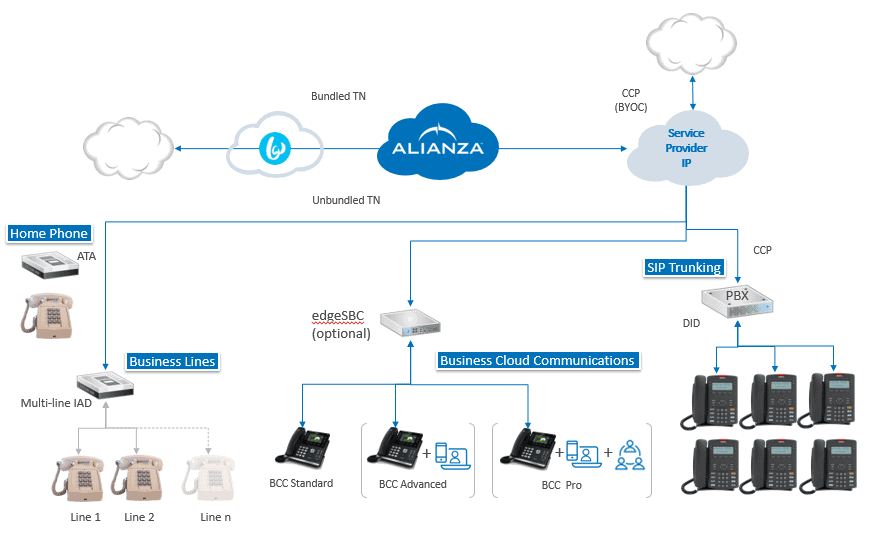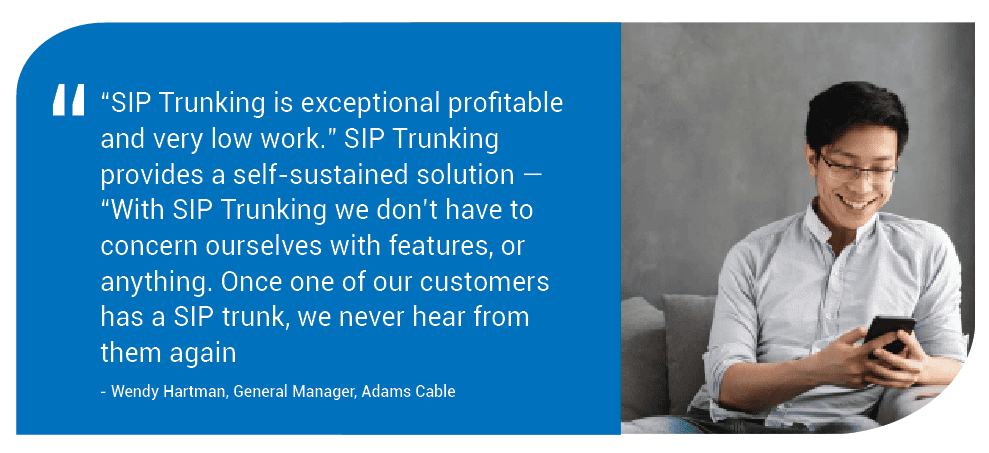
SIP trunk providers are increasingly gaining traction in a competitive market, because customers who aren’t ready to give up their IP PBX investments have turned to SIP Trunking for it’s cost savings and flexibility. SIP Trunking is one of the most cost-effective cloud communication solutions because it’s easy to implement and uses the customer’s existing on-premises PBX equipment. SIP trunk providers can offer their customers unlimited calls, low call rates, and an easy setup process.
SIP Trunking is separate from cloud hosted services because it requires the customer to already have an on-premises PBX. The cloud data network provides a reliable connection that does not require any additional wiring or hardware. It’s a great transitional solution for enterprises that want the benefits of enhanced communication services but aren’t ready to migrate to a cloud PBX platform. This blog post will share everything you need to know about SIP trunks and 8 ways SIP Trunk providers can benefit!
What Is SIP Trunking?
SIP, short for Session Initiation Protocol, is essentially a way to make connections for data and voice transfers over the internet. A SIP trunk creates a connection from the customer’s on-site PBX system to your VoIP network, using your broadband to replace the telco PRI and connect your customers with the public switched telephone network (PSTN).
SIP Trunking is a secure, reliable, and flexible cloud-based voice solution that allows companies to consolidate their communications onto their existing data network. By using VoIP technology to transmit calls across the internet, service providers can offer customers better rates and flexibility without sacrificing quality or reliability.
How Many Channels Does a SIP Trunk Have?
A single SIP trunk can support one to many hundreds of simultaneous calls, or channels, meeting the needs of organizations both large and small. As calls are connected and disconnected, the number of active channels on a SIP trunk will expand and shrink. If the trunk allows 50 calls and only 12 are in use, 38 channels are still available for new calls. Channels can also be increased or decreased as needed to meet demand.
This type of service can provide substantial cost savings over more traditional cloud PBX solutions, especially for customers who are looking for enhanced connectivity to their existing on-premises PBX. Organizations with a high volume of calls — like apartments, hospitals, hotels, office buildings, schools, etc. — can benefit most from the flexibility and cost-effectiveness that SIP Trunking provides.

How Many SIP Trunks Does a Small Business Need?
Since a SIP trunk can accommodate any number of channels, many customers need only one, though additional trunks may be wanted for overflow and failover routing. The number of channels required on a trunk is determined by the number of concurrent calls the organization frequently conducts. In terms of function, channels are comparable to regular phone lines.
Depending on the size of your customer, a SIP Trunk providers can gauge the number of SIP trunks a customer needs based on the number of PRI/T-1s or plain old telephone system (POTS) lines they currently have. This determines the number of call paths your customer will be able to make between the PTSN and their analog PBX.
Generally, you can determine the number of concurrent calls and adding a 20% buffer is a reasonable proposal to ensure your customers have sufficient coverage.
How Much Does a SIP Trunk Cost?
One of the biggest benefits of SIP Trunking is that it can save money in two ways: by reducing costs internally (by allowing companies to consolidate phone lines) and by providing competitive rates externally (to attract new clients). As a result, SIP trunk providers can offer VoIP without asking customers to invest in expensive hardware — all they need is an internet connection.
Costs will vary per SIP trunk provider but are generally based on the number of concurrent calls allowed on the trunk, the number of minutes used per month, and call features. There may also be other fees involved, such as installation or setup charges. Check with your VoIP provider for current rates.

What Is the Difference Between Sip Trunking and VoIP?
SIP Trunking and VoIP work together but are not the same thing. SIP requires VoIP, but VoIP doesn’t require SIP.
VoIP, which stands for Voice over Internet Protocol, is used to make phone calls made over the internet. SIP, or Session Initiation Protocol, is a set of rules used in multimedia communications to transfer data between users. A SIP trunk acts as a virtual phone line and uses the SIP protocol to connect calls with VoIP. A SIP trunk also has SIP channels which act as individual calls.
SIP Trunk vs PRI
SIP trunks are sometimes referred to as PRI connections. The Public Switched Telephone Network (PSTN) is connected to a Primary Rate Interface system (PRI trunk), whereas a SIP trunk connects to the PSTN as a virtual connection. Voice calls are sent over an existing ethernet or fiber connection using a SIP trunk. SIP trunk providers configure and maintain the connection.
SIP Trunk vs DID
The connection between the phone and the internet is known as a SIP trunk. A DID (direct inward dialing, is a virtual telephone number that isn’t connected to a specific phone or line and allows users to redirect and route calls. Because it’s a proxy for an actual number, it can be assigned to any phone or device. The SIP trunk links a call to the internet and the DID sends the call to the correct phone.
8 Ways SIP Trunk Providers Benefit
Ditch costly and inflexible phone services that hinder small-business expansion. SIP trunk providers (service providers offering a SIP Trunking service) can increase recurring revenue, loyalty, and customer lifetime value. Here are a few more benefits:
- Virtually Zero Maintenance. No in-house technical expertise or personnel needed to maintain the SIP network, meaning happier customers with less effort on your side.
- Reduce Customer Hesitancy. Changing to the cloud is simple and stress-free, requiring no expensive hardware or expertise.
- Customer Stickiness. By combining customer services, you can offer enticing savings on local and long-distance calling.
- Simplified Scalability. As your customers’ demands alter, you can instantly increase or decrease the number of channels available on the trunk. This increased flexibility means healthy margins for your business.
- Easy Onboarding. Mature cloud communications providers will offer an intuitive platform so customers can make changes in minutes and get back to work.
- Instant ROI. No upfront risk or investment means service providers can move faster and achieve a higher return on investment.
- Right-Sized Flexibility. SIP Trunking offers limitless bandwidth and is extremely flexible. There’s no need for a physical installation or setup, as the system works by connecting your PBX to existing IP-based trunks.
- Remote Locations. A SIP trunk is a secure, reliable way to connect branch offices and remote workers. Since it uses an internet connection rather than phone lines, a service provider can distribute connections over multiple locations without adding another physical line or upgrading existing ones, which would be expensive for customers. This makes SIP Trunking a cost effective, scalable solution for businesses that need to cover multiple locations or remote workers.
How Do I Become a SIP Trunk Provider?
To become a SIP trunk provider, you need three things:
- Find a Provider. Choose a reputable SIP Trunking platform or reseller program. A service provider-focused carrier will provide superior benefits that SMB or enterprise specific companies won’t.
- A High-Quality Internet Connection. SIP trunks utilize your existing broadband network, meaning no additional infrastructure is needed.
- Go-to-Market Plan. Once you’ve chosen the best SIP trunking supplier, your can start building your customer base and become thinking about how to get the word out to potential customers. This could include preparing a marketing or sales pitch.
TIP: Ask your chosen SIP trunking provider if they offer marketing and sales support in the form of brandable user guides, customer-facing marketing sheets, or go-to-market strategies that will reduce your asset development costs and effort, therefor increasing your speed to market and increasing your ROI.
How Do I Get a SIP Trunk?
Even if you don’t yet offer SIP trunking to your customers, its easy to start. If you already have an establish cloud communications provider, setting up a SIP trunk is easy. But if you’re still in the market to become a SIP trunk provider, look for a carrier who is focused on supporting service providers, as they’re more likely to offer features like intuitive portals that allows users manage their SIP trunk settings. This is important as it takes much of the burden of support off the service provider. In addition, an ideal solution will have multiple SIP Trunks that allow for calls to failover to associated Trunks, seamlessly allowing your customers service to continue if something happens to prevent calls in one office.
In a competitive market for VoIP and SIP trunk services, staying true to quality and solution-driven, innovative services are essential to keep your business afloat. Premium features, quality, reach, and coverage are all crucial factors why you should opt for a quality service partner like Alianza. We offer free consultations and best of all — we’re committed to helping you find the right solution.




